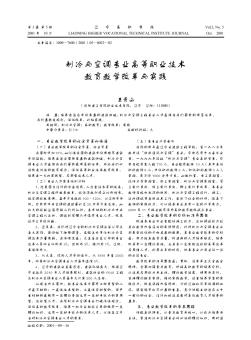Unit t Fundamentals of Refrigercrtion.
Text 1: History of Refrigeration and Air Conditioning
Supplementary Reading: Refrigeration
Text 2: Heat and Temperature
Supplementary Reading (1): Heat Transfer
Supplementary Reading (2): Sensible Heat, Latent Heat and Specific Heat
Text 3: Pressure
Supplementary Reading: Pressure and Temperature Relationship
Unit 2 CompressJon System and Compressors
Text 4: The Refrigeration Process
Supplementary Reading: Refrigeration and Air Conditioning
Text 5: Refrigerants
Supplementary Reading: Refrigeration Oil
Text 6: The Compressors
Supplementary Reading: Refrigerator's Lubrication
Text 7: The Evaporator and Condenser
Supplementary Reading: Cooling Towers and Pumps
Text 8: The Refrigerant Metering Device
Supplementary Reading: Refrigeration Accessories
Unit 3 Automatic Control Components and Applications
Text 9 : The Fundamentals of Electrical Circuit
Supplementary Reading: Motor Start Relay
Text 10 : Semiconductors
Supplementary Reading: Printed Circuit Boards and Integrated Circuits
Text 11 : Introduction to Automatic Controls
Supplementary Reading: Temperature Control Principle
Text 12 : Electric Circuit——Complete Wiring Diagram
Supplementary Reading: Troubleshooting Basic Controls
Unit 4 Domestic Refrigerators- Freezers and Commercial Systems
Text 13 : Domestic Refrigerators
Supplementary Reading: Domestic Freezers
Text 14 : Commercial Refrigeration Systems
Supplementary Reading: Walk-in Refrigerators
Text 15 : Truck Refrigeration Systems
Supplementary Reading : Quick Freezing Methods
Unit 5 Air Conditioning System
Text 16 : Air Conditioning
Supplementary Reading: Atmosphere Cooling
Text 17 : Window Units
Supplementary Reading: Heat Pumps
Text 18 : Central Air Conditioning Systems
Supplementary Reading: Chilled Water Systems
参考译文
词汇表
参考文献

 制冷与空调专业高等职业技术教育教学改革与实践
制冷与空调专业高等职业技术教育教学改革与实践

 制冷与空调专业英语的教学方法探讨
制冷与空调专业英语的教学方法探讨